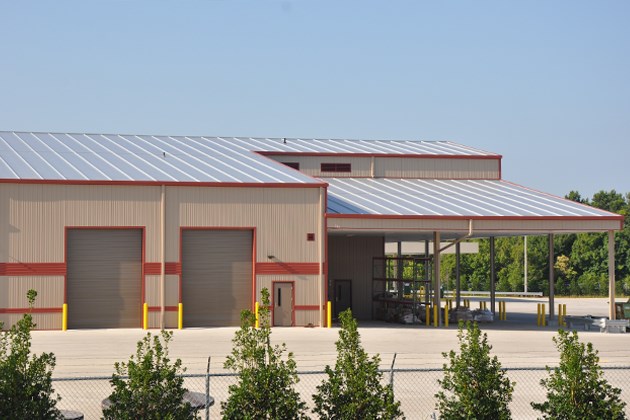Metal roof and wall panels have many test standards they must meet under certain environmental conditions. Test standards that are specified for metal panels in our industry are ASTM E283 (air leakage) and ASTM E331 (water penetration) for wall panels, and ASTM E1680 (air leakage) and ASTM E1646 (water penetration) for roof panels. While the corresponding tests are similar, the orientation of the panels is a little different for the wall and roof panels. Here we’ll take a brief look at these testing protocols and what they mean for the integrity of the metal panel system at hand.
For air leakage tests, the protocol has been to test at a specified pressure. It should be noted that some manufacturers have changed it from the standard as many in the market are testing at a higher pressure. And while it’s true that you are going to have air pass through, you want the air to be minimized. Air leakage is tested in terms of cubic feet per minute, with a lower number indicating a better, more efficient product. For water penetration testing, water is sprayed and is tested for the water getting through the seam or side lap of the panel system.

Metal Wall Testing Standards
As indicated above, the wall test standards are: ASTM E283 (Standard Test Method for Determining Rate of Air Leakage Through Exterior Windows, Curtain Walls, and Doors Under Specified Pressure Differences Across the Specimen) and ASTM E331 (Standard Test Method for Water Penetration of Exterior Windows, Skylights, Doors, and Curtain Walls by Uniform Static Air Pressure Difference).
The procedure for ASTM E283 is as follows: 1. Seal off test unit and measure air leakage (extraneous leakage); 2. Unseal test unit, then re-measure (total system); 3. Subtract extraneous air from total air = Performance.
According to ASTM, this test method is a “standard procedure for determining the air leakage characteristics under specified air pressure differences at ambient conditions.” Furthermore, the air pressure differences across a building envelope can have significant variation with numerous factors acting to affect air pressure differences relative to the particular building environment. For instance, the test method described is for tests with constant temperature and humidity across the specimen. These factors should be considered when specifying the test pressure differences to be used.
Additionally, rates of air leakage are sometimes used for comparison purposes but these comparisons would only be valid if the tested/compared components are of essentially the size, configuration, and design.
Using a Pass/Fail criteria, “Pass” results of this test indicated that water did not penetrate through control joints in the exterior wall envelope, joints at the perimeter of openings, or intersections of terminations.
The laboratory test procedure for ASTM E331 dictates that the test is conducted for a specified duration with water applied at 5.0 gal/ft 2 hr. at a specified pressure. The test has applied pressure and water spray for a period of 15 minutes.
According to ASTM, this test method is a “standard procedure for determining the resistance to water penetration under uniform static air pressure differences.” Furthermore, in applying the results of tests by this test method, ASTM points out that “the performance of a wall or its components, or both, may be a function of proper installation and adjustment. In service, the performance will also depend on the rigidity of supporting construction and on the resistance of components to deterioration by various causes, vibration, thermal expansion and contraction, etc.,” noting that exact simulation of real-world wetting conditions can be difficult (i.e., large wind-blown water drops, increasing water drop impact pressures with increasing wind velocity, and lateral or upward moving air and water) – and that it may depend to some degree on the design.
Metal Roof Test Standards
The Roof Test Standards are ASTM E1680 (Standard Test Method for Rate of Air Leakage Through Exterior Metal Roof Panel Systems) and ASTM E1646 (Standard Test Method for Water Penetration of Exterior Metal Roof Panel Systems by Uniform Static Air Pressure Difference).
According to ASTM, test method E1680 covers the determination of the resistance of exterior metal roof panel systems to air infiltration resulting from either positive or negative air pressure differences. The test method described is for tests with constant temperature and humidity across the specimen. (This test method is a specialized adaption of Test Method E283.)
ASTM literature explains that variables such as the slope of the roof and other factors can affect air pressure differences and, therefore, affect the implications of the resulting air leakage relative to the environment within buildings. Just as with wall panels discussed earlier, these factors need to be taken into consideration when specifying the test pressure difference to be used.
ASTM describes its E1646 test method as a “standard procedure for determining the resistance to water penetration under uniform positive static air pressure differences, and simulates win driven rain imposed on sidelaps and rain that is free to drain while building a water head as it flows.” For this test method, the slope of the roof is a significant factor.
According to ASTM, this test method covers the determination of the resistance of exterior metal roof panel systems to water penetration when water is applied to the outdoor face simultaneously with a static air pressure at the outdoor face higher than the pressure at the indoor face, that is, positive pressure. (This test method is a specialized adaption of Test Method E331.)
To learn more about MBCI wall and roof panels, please visit www.mbci.com.